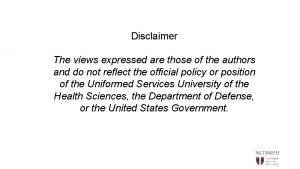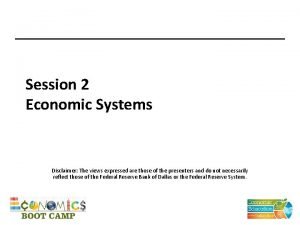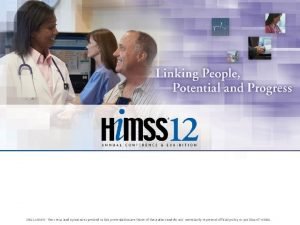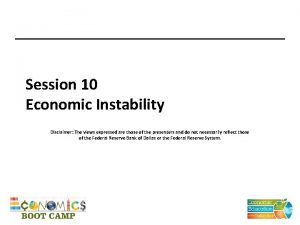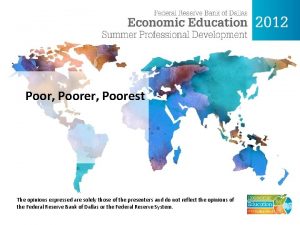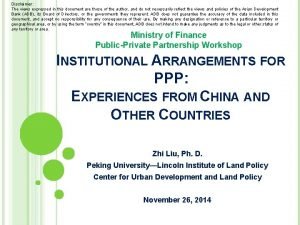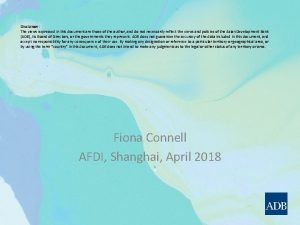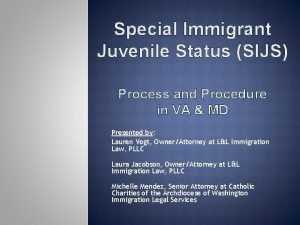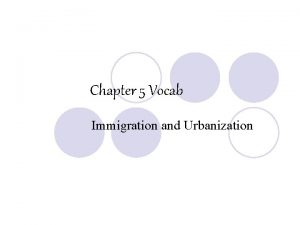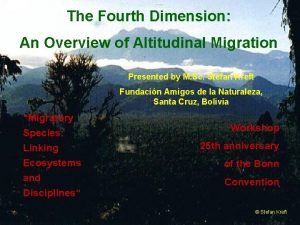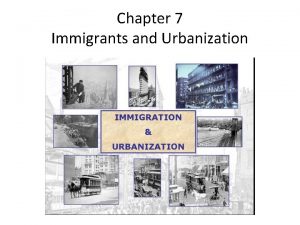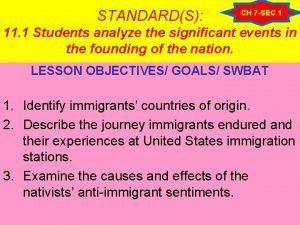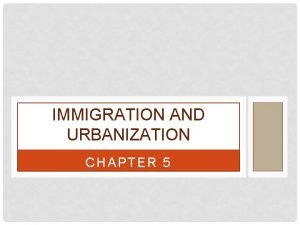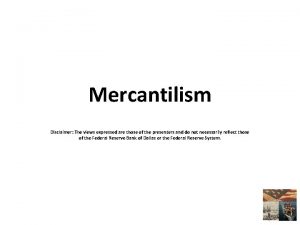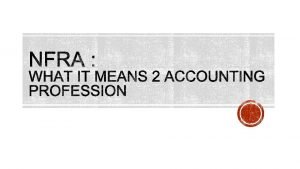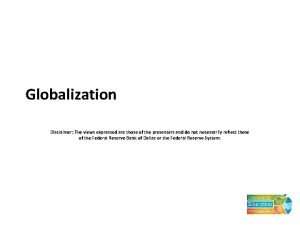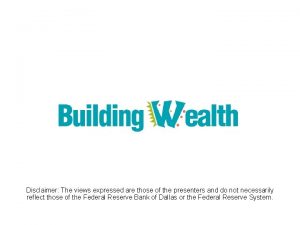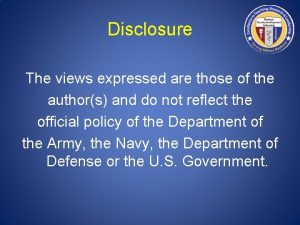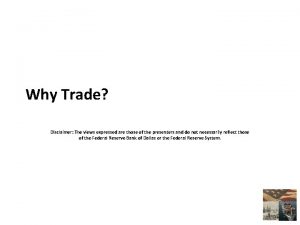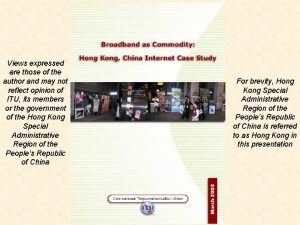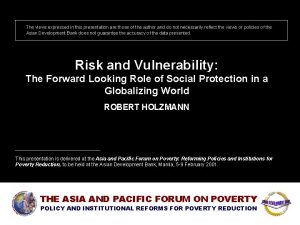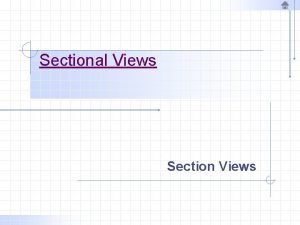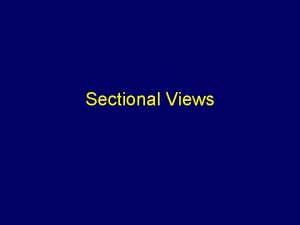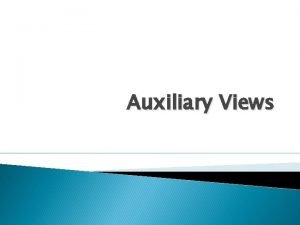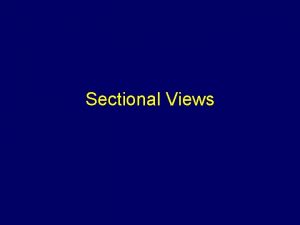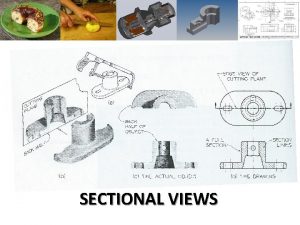Immigration The views expressed are those of the





















- Slides: 21

Immigration The views expressed are those of the presenter and do not reflect the views or position of the Federal Reserve Bank of Dallas or the Federal Reserve System.

Where are we going? • Immigration is a concept that appears in various locations in the TEKS • The sweep of the story is important • Modern debates about immigration are not new • The needs of the economy are a powerful force

A Change in View • Before 1817 – settlers were referred to as “emigrants” because they had migrated from somewhere • After 1817 – settlers were referred to as “immigrants” because they had come to a new nation

Before 1875 • Free immigration • Few federal laws – Naturalization Act of 1790 established rules for citizenship but not immigration • Why? – Populate the country – Allow for growth and development – National defense (claim the land)

Early Opposition • Nativism – Anti-Catholic – Fear of radicals, especially poor • Regional patterns lead to localized opposition – Irish immigration to New York and Massachusetts – Chinese immigration to California • 1876 – Henderson v. Mayor of New York affirmed that Congress had the sole right to regulate immigration

Legislation • • Immigration Act of 1882 – 50 cent head tax Chinese Exclusion Act of 1882 Gentlemen’s Agreement of 1907 Immigration Act of 1917 – literacy test

Goals of Immigration Policy • Exclude the undesirables – Criminals and prostitutes (Page Act of 1875) – Lunatics and people likely to become a public charge (Immigration Act of 1882) – Anarchists, people with epilepsy, beggars, prostitutes and importers of prostitutes (Immigration Act of 1903) – Paupers, polygamists and illiterate adults (1907 and 1917) • Protect workers from competition – Contract labor laws of 1885 and 1887

National Origins Quotas • Two acts – Emergency Quota Act of 1921 – Immigration Act of 1924 • Limited immigration to 3% of the 1910 population, then 2% of the 1890 population • Sought to favor immigrants from western and northern Europe

Other Provisions of 1924 • Asian immigration further constrained – Prevented from naturalizing by earlier legislation – Prevented from entering because they could not be naturalized • Mexico and Canada were non-quota nations – When supply of European labor was cut off, immigration from Mexico spiked

Legal Permanent Residents from Mexico 621, 218 498, 945 441, 824 273, 847 185, 334 32, 709 31, 188 3, 835 7, 187 3, 069 3, 446 1, 950 5, 133 2, 405 734 1820 s 1830 s 1840 s 1850 s 1860 s 1870 s 1880 s 1890 s 1900 s 1910 s 1920 s U. S. Department of Homeland Security. (2011). Yearbook of Immigration Statistics: 2010. Washington, DC: U. S. Department of Homeland Security. 1930 s 56, 158 1940 s 1950 s 1960 s 1970 s

Great Depression • Richard Goodman, Program #1977 -09, Mexican Americans During the Great Depression, www. laits. utexas. edu/onda_latina/index.

World War II and the Bracero Program • Created in 1942 to address wartime labor shortages • Brought in about 200, 000 Mexican workers annually for 22 years • Intended to admit workers for short-term employment

Mc. Carren-Walter Act (1952) • Reaffirmed a strict quota system • Ended Asian exclusions, but did not equalize treatment • Created a preference system within each country’s quota allotment – Half went to “highly skilled immigrants whose services are urgently needed” – Half went to family members of permanent residents

Truman’s Veto • Strongly worded veto on June 25, 1952 • “The greatest vice of the present quota system, however, is that it discriminates, deliberately and intentionally, against many of the peoples of the world. ” • Congress passed the bill over Truman’s veto on June 27.

Growth of Illegal Immigration • Bracero Program was highly bureaucratic and was often bypassed • Strong demand for labor incentivized migration • Texas growers were initially excluded from the Bracero Program and lobbied for the “Texas proviso” in the Mc. Carren-Walter Act • Proviso explicitly permitted the employment of illegal immigrants

Hart-Cellar Act (1965) • Ended the provisions that discriminated against Asians and mandated that the quota system be phased out by 1968 • Placed a ceiling on immigration – Western Hemisphere – 120, 000 – Eastern Hemisphere – 170, 000 • New preference system – Strongly favored family reunification – Non-family immigrants required to certify that American workers were not available for their jobs

Revisions • Hart-Cellar treated Eastern and Western Hemispheres differently • 1976 – Preference system and labor certification requirements for EH and WH reconciled – Country cap of 20, 000 was extended to WH • 1978 – EH and WH ceilings were combined for a total ceiling of 290, 000

Implications for Mexico • Bracero Program had allowed 200, 000 seasonal or temporary workers each year • New ceiling of 20, 000 permanent residents from Mexico • No program for seasonal workers • Estimates suggest that from 1965 to 1986 there was – Net undocumented inflow of 4. 6 million Mexicans – Less than 1. 3 million Mexicans granted legal permanent resident status

Immigration Reform and Control Act (1986) • Allowed unauthorized immigrants to legalize their status • Required employers to verify legal status to work in the U. S. (and established employer penalties) • Created a temporary immigration program for seasonal agricultural workers (H-2 A program)

Other Changes • Immigration Act of 1990 – Raised the total limit and cap on employmentbased permanent immigration – Created H-1 B (skilled) and H-2 B (unskilled) temporary worker programs – Maintained emphasis on family ties and created some special exceptions • NAFTA – Created TN program for temporary work permits for Canadian and Mexican professionals

Sources • Harry S. Truman: "Veto of Bill To Revise the Laws Relating to Immigration, Naturalization, and Nationality. , " June 25, 1952. Online by Gerhard Peters and John T. Woolley, The American Presidency Project. http: //www. presidency. ucsb. edu/ws/? pid=14175. • U. S. Department of Homeland Security. (2011). Yearbook of Immigration Statistics: 2010. Washington, DC: U. S. Department of Homeland Security. • National Research Council. (2013). Options for Estimating Illegal Entries at the U. S. –Mexico Border. Panel on Survey Options for Estimating the Flow of Unauthorized Crossings at the U. S. -Mexican Border, A. Carriquiry and M. Majmundar, Eds. Committee on National Statistics, Division of Behavioral and Social Sciences and Education. Washington, DC: The National Academies Press. • Pia M. Orrenius and Madeline Zavodny. Beside the Golden Door: U. S. Immigration Reform in a New Era of Globalization. Washington, D. C. : AEI Press, 2010.
 Insidan region jh
Insidan region jh Googlemoa
Googlemoa The views expressed
The views expressed The views expressed disclaimer
The views expressed disclaimer All views expressed disclaimer
All views expressed disclaimer Views expressed disclaimer
Views expressed disclaimer The views and opinions expressed
The views and opinions expressed Views and opinions disclaimer
Views and opinions disclaimer Disclaimer the views expressed
Disclaimer the views expressed The views expressed disclaimer
The views expressed disclaimer Sijs immigration
Sijs immigration Chapter 5 immigration and urbanization
Chapter 5 immigration and urbanization Fourth dimension immigration
Fourth dimension immigration Chapter 7 building vocabulary immigration and urbanization
Chapter 7 building vocabulary immigration and urbanization Jennie ellis australia immigration
Jennie ellis australia immigration This is why people migrate aj+
This is why people migrate aj+ Market revolution immigration
Market revolution immigration European immigration
European immigration Topic 2 industry and immigration
Topic 2 industry and immigration What is immigration
What is immigration Chapter 5 immigration and urbanization
Chapter 5 immigration and urbanization European immigration to texas
European immigration to texas


